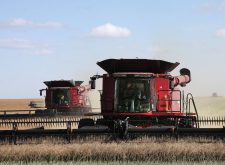WASHINGTON, June 12 (Reuters) – Despite a cold, wet spring that delayed planting, U.S. corn and soybean farmers are headed for record harvests that mean abundant supplies and sharply lower market prices through fall 2014, the U.S. government said on Wednesday.
Globally, though, ending stocks of wheat, corn and soybeans for 2013-14 will be slightly below projections from a month ago as production outlooks dimmed in some countries.
The Agriculture Department pared its projection of the corn crop by 1 percent, to 14.005 billion bushels. Traders had expected a 2.2 percent drop. USDA pegged 2013-14 corn ending stocks of 1.95 billion bushels, down from May but still the largest in eight years and more than eight percent larger than the 1.8 billion traders expected.
Read Also

U.S. grains: Soybeans rise on China demand hopes; corn and wheat rebound
Chicago Board of Trade soybean, corn and wheat futures rose on Monday on signs of progress towards the end of a record-long U.S. government shutdown, along with expectations of a revival of U.S. soybean exports to China, analysts said.
If realized, the corn crop would be a billion bushels larger than the record set in 2009. The soybean crop would also be a record at 3.39 billion bushels, slightly larger than the 2009 mark.
Bumper crops would be a dramatic rebound from three years in a row of falling corn and soybean production, tightening stocks and sky-high prices.
Corn stocks are headed for the smallest level in 17 years in 2012-13, with supplies to be razor-thin until harvest starts in the fall.
Soybeans stocks for 2013-14 are projected to double from the current year, said USDA.
Earlier this week, traders said they expected the chilly, wet spring would force USDA to lower its forecasts of corn plantings by 1.5 million acres and soybeans by 700,000 acres.
In fact, USDA held steady to its plantings estimates but lowered the projected corn yield by one percent.
“Despite rapid planting progress during mid-May across the Corn Belt, rains and cool temperatures since have delayed the completion of planting in parts of the western Corn Belt and raised the likelihood that seasonally warmer temperatures and drier conditions in late July will adversely affect pollination and kernel set in a larger share of this year’s crop,” said USDA.
In its monthly crop report, USDA estimated the winter wheat crop at 1.51 billion bu., up two percent from its initial estimate. Yields are up throughout the Wheat Belt despite drought lingering in the southern Plains.
At the start of this week, five percent of the the corn and 29 percent of soybeans were still not planted. Late planting usually means lower yields and in some cases, farmers do not plant at all. This spring was the slowest planting season in 17 years.
USDA cut 5.6 million tonnes from global wheat supplies for 2013-14, reflecting smaller crops expectred from Ukraine, Russia and Europe blamed partly on dry weather.
Brazil’s soybean crop for 2012-13, still being harvested, was trimmed by 1.5 million tonnes to 82 million, reflecting dry conditions in the nation’s northeast.














